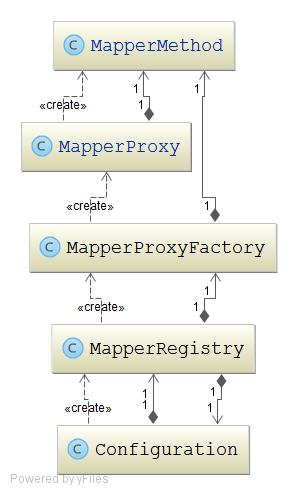上一篇:
https://my.oschina.net/u/657390/blog/748646
MapperMethod与MapperProxy,MapperProxyFactory,MapperRegistry,Configuration之间的关系

在分析mapper动态代理的时候可以看出最终执行的是mapperMethod.execute
public Object invoke(Object proxy, Method method, Object[] args) throws Throwable {
try {
//当执行的方法是继承自Object时执行this里的相应方法
if (Object.class.equals(method.getDeclaringClass())) {
return method.invoke(this, args);
} else if (isDefaultMethod(method)) {
return invokeDefaultMethod(proxy, method, args);
}
} catch (Throwable t) {
throw ExceptionUtil.unwrapThrowable(t);
}
//最终执行的是mapperMethod.execute
final MapperMethod mapperMethod = cachedMapperMethod(method);
return mapperMethod.execute(sqlSession, args);
}接着分析mapperMethod.execute()
首先看MapperProxy中cachedMapperMethod(method)
/**
* methodCache中已经存在传入的参数method
* 则从methodCache中取MapperMethod,
* 否则根据method生成MapperMethod实例并存储到methodCache中
*
* @param method
* @return
*/
private MapperMethod cachedMapperMethod(Method method) {
MapperMethod mapperMethod = methodCache.get(method);
if (mapperMethod == null) {
mapperMethod = new MapperMethod(mapperInterface, method, sqlSession.getConfiguration());
methodCache.put(method, mapperMethod);
}
return mapperMethod;
}MapperProxy中methodCache
private final Map<Method, MapperMethod> methodCache;
追溯methodCache的来源
//MapperProxy构造方法
public MapperProxy(SqlSession sqlSession, Class<T> mapperInterface, Map<Method, MapperMethod> methodCache) {
this.sqlSession = sqlSession;
this.mapperInterface = mapperInterface;
this.methodCache = methodCache;
}MapperProxyFactory中
private final Map<Method, MapperMethod> methodCache = new ConcurrentHashMap<Method, MapperMethod>();
public T newInstance(SqlSession sqlSession) {
final MapperProxy<T> mapperProxy = new MapperProxy<T>(sqlSession, mapperInterface, methodCache);
return newInstance(mapperProxy);
}从MapperProxyFactory的源码中可以看出methodCache最初是一个空的ConcurrentHashMap,
从MapperProxy中cachedMapperMethod(method)可以看出
methodCache中已经存在传入的参数method, 则从methodCache中取MapperMethod, 否则根据method生成MapperMethod实例并存储到methodCache中.
接着看MapperMethod的源码
构造方法
/**
* @param mapperInterface 接口
* @param method 调用的方法
* @param config 配置
*/
public MapperMethod(Class<?> mapperInterface, Method method, Configuration config) {
this.command = new SqlCommand(config, mapperInterface, method);
this.method = new MethodSignature(config, mapperInterface, method);
}创建了SqlCommand和MethodSignature实例
command type
public enum SqlCommandType {
UNKNOWN, INSERT, UPDATE, DELETE, SELECT, FLUSH;
}MapperMethod中最重要的方法
public Object execute(SqlSession sqlSession, Object[] args) {
Object result;
switch (command.getType()) {
case INSERT: {
Object param = method.convertArgsToSqlCommandParam(args);
result = rowCountResult(sqlSession.insert(command.getName(), param));
break;
}
case UPDATE: {
Object param = method.convertArgsToSqlCommandParam(args);
result = rowCountResult(sqlSession.update(command.getName(), param));
break;
}
case DELETE: {
Object param = method.convertArgsToSqlCommandParam(args);
result = rowCountResult(sqlSession.delete(command.getName(), param));
break;
}
case SELECT:
if (method.returnsVoid() && method.hasResultHandler()) {
executeWithResultHandler(sqlSession, args);
result = null;
} else if (method.returnsMany()) {
result = executeForMany(sqlSession, args);
} else if (method.returnsMap()) {
result = executeForMap(sqlSession, args);
} else if (method.returnsCursor()) {
result = executeForCursor(sqlSession, args);
} else {
Object param = method.convertArgsToSqlCommandParam(args);
result = sqlSession.selectOne(command.getName(), param);
}
break;
case FLUSH:
result = sqlSession.flushStatements();
break;
default:
throw new BindingException("Unknown execution method for: " + command.getName());
}
if (result == null && method.getReturnType().isPrimitive() && !method.returnsVoid()) {
throw new BindingException("Mapper method '" + command.getName()
+ " attempted to return null from a method with a primitive return type (" + method.getReturnType() + ").");
}
return result;
}首先调用MethodSignature里的
public Object convertArgsToSqlCommandParam(Object[] args)
处理参数.然后,
如果command type是
INSERT, UPDATE, DELETE
则直接调用sqlSession的相应方法
如果command type是
SELECT
则根据返回结果调用sqlSession里相应的查询方法.
至此MapperMethod从创建到执行的过程都大致分析了一遍.